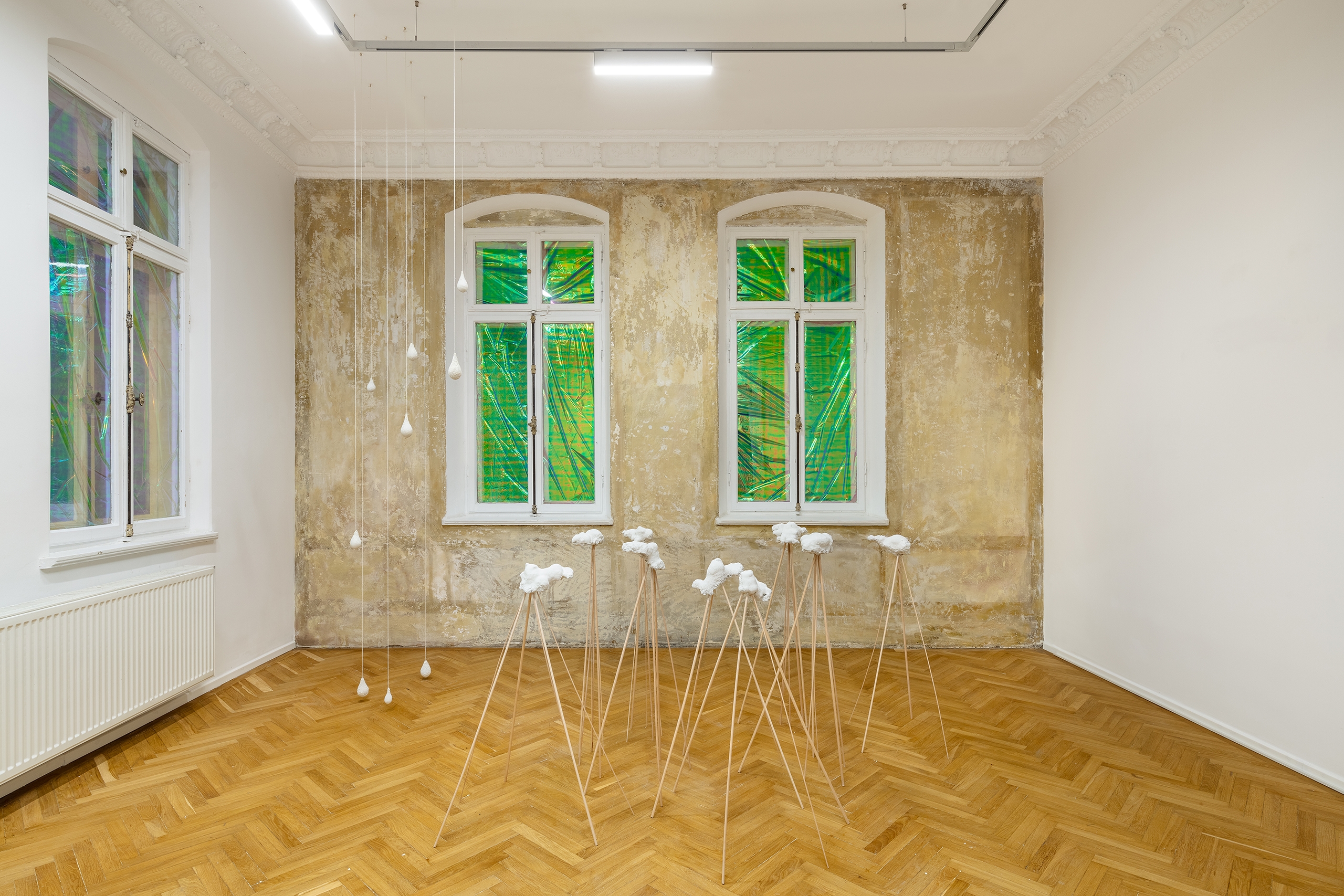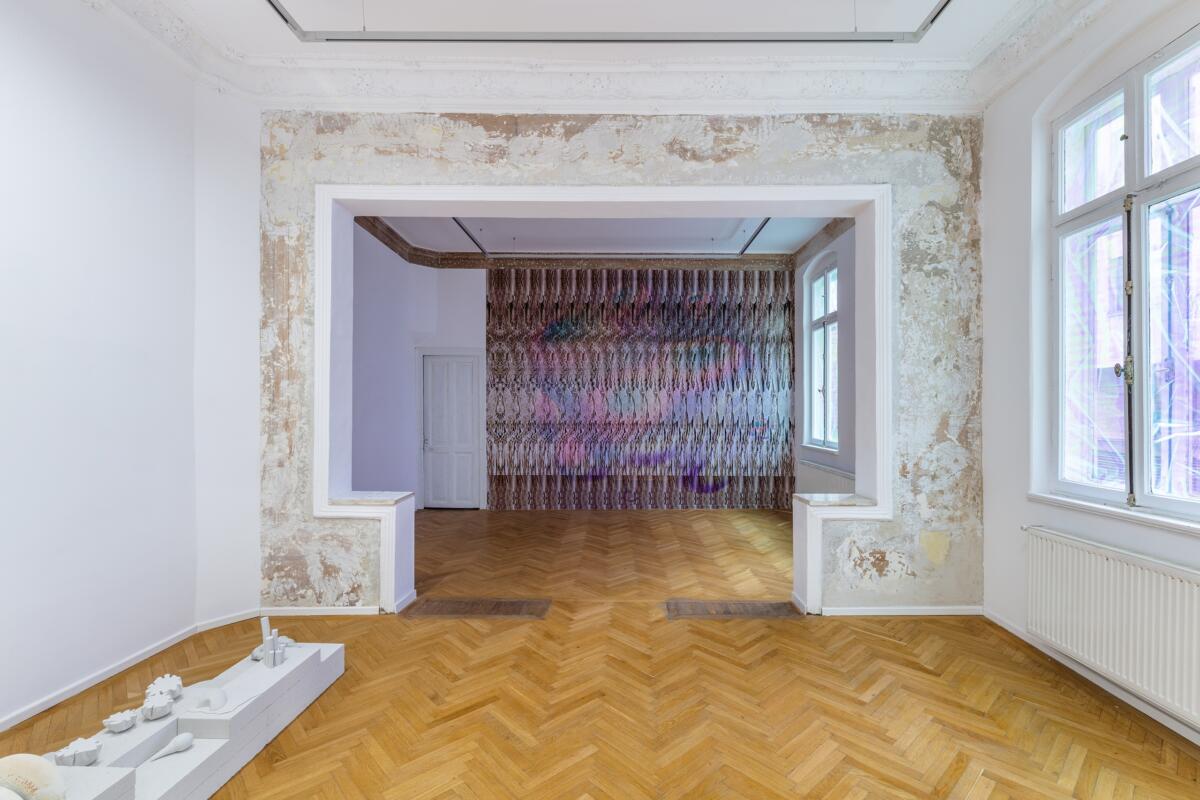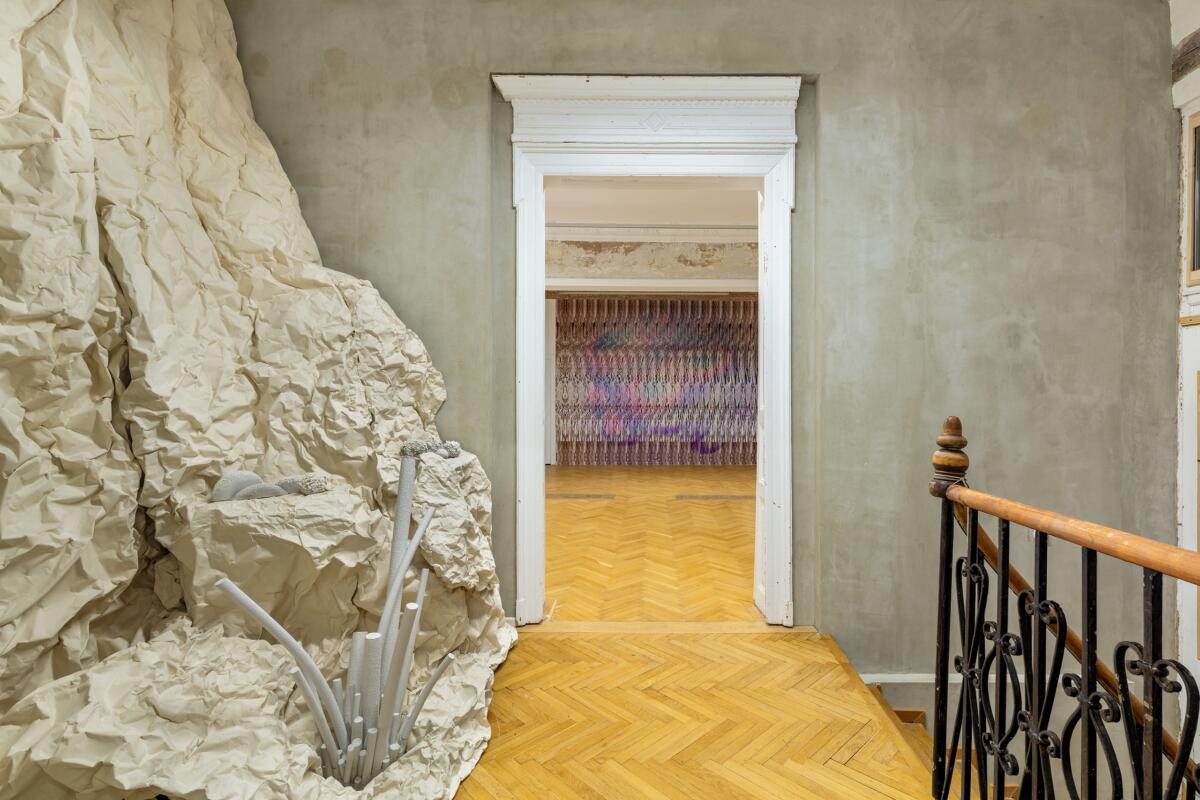
The pastel-chipped walls of one of the most special contemporary art spaces in Bucharest are rising from a soft and warm wooden floor, which reacts discretely as you walk over its surface. You go up a few steps and you are greeted by an image with an intense presence on the vertical axis, in front of you, an image that you invariably miss out on first contact because its frontality escapes you in its dramatic effect, as the gallery always effectively sets out to host right at the entrance. The discreet and gentile ochre nuances of the walls embroidered with “ragged” plaster, the format, and the glazing of the woodwork on the windows, the delicate scaffolding kept at the base of the ceiling, the vaguely intuited proximity of a dark basement that presses from the bottom up as you climb the entrance steps, make this charismatic space a challenge to choose to work with. It is located in an area of beautiful villas from other times, in an urban environment where anyone can strongly feel the olfactory and textural presence of the earth, the gardens, the bricks clustered into the walls, the clay in the tiles of the high stoves. You can smell the thick trees crowded on the sidewalks broken by too much surrounding vegetation, at times even secular trees, all around the gallery in one of the most aesthetically pleasing urban areas in the centre of Bucharest.
Working together with curator Cristina Stoenescu on an exhibition on materiality, and therefore on time, Anetta Mona Chișa spent a few weeks in the gallery space installing her strange “objects”. Minor entities with a harmless objectual allure that confers upon them an inexplicable force of seduction, they are the active elements of a conceptual arrangement on matter, time, transition, about (in)organic existence and cosmic fatality under the sign of which there are all the elements that make up both the great world that overwhelms us, and the small world of our bodies and minds, in an exhibition of emotionally touching beauty.
Acutely sensorial despite its restrained and minimal appearance, the project offers itself a possible key to understanding à rebours: any possible interpretation of it becomes, no matter how inspired the receiver, a pale footnote to the wonderful presentation text of the previous exhibition ”Cozy Cosmos Cosmetics” by Anetta Mona Chișa with Martin Piaček from 2019-2020. Only that title catches our attention from the beginning, describing a project that continued a previous, cumulative interest of the artist around the conceptualization of the subject, as “a brief biography of calcium”. Inspired by Roger Caillois’s ”L’Écriture des pierres”, it was there, as much as it is here at Anca Poterașu in a more abbreviated, even more elegant and synthetic version, about “the search for order and beauty in the molecular cosmos of calcium compounds “, about shells and vertebrae, about the Earth’s crust, mammalian bones, pigments, alabaster, marble and plaster “which were already speaking volumes about their conflicts, alliances and aspirations hundreds of millions of years ago”. A haloed element (scientifically correct) with the status of interstellar presence even before the birth of our galaxy, calcium is thus the protagonist of a mineral lyricism developed as a “romance based on a material ontology and a material consciousness.”
Under the windows covered in the exhibition with a translucent foil in metallic lustre, in the bright space of the former home on Popa Soare Street, shapes with the appearance of blobjects of a colder white, greyer than the creamy milk of the walls, have the grainy textures of shaped pieces of chalk and appear to be the moulds of some strange technical components with organic, cellular design. Arranged neatly on the floor, on the wall, hanging from above, they immediately raise suspicions, and you will soon find out why: on their curved surfaces the purist modernism of the inorganic yields to the calm and silent assault of several calcium carbonate (limestone) “flowers” grown there after the moulds had been imbued into an acetic acid solution (vinegar) in which eggshells and seashells had dissolved. The white of these crystalline mould flowers transformed yellow and then brown as the limestone accumulated, under the eyes and already sensitized nose of all those who have witnessed for a few moments the formation of the calcareous growth.

Anetta Mona Chisa, Temporal Parts (The Archive) (detail), 2021, installation, plaster casts, concrete bricks
The environment of the micro (bio) geology process is the gallery itself, modestly staging, on the scale of a refined bio-modernist embroidery, the great metamorphoses of the survival of the chemical elements in the universe. The delicate organic relief with the appearance of an ornament, which you want to touch to convince yourself that it is not fake, puts you not only in visual contact with the solid matter that shapes into beads, but also emitting carbon dioxide in the process. It is therefore also a staging for visitors becoming the aerial receptacle of some by-products resulting from the whole affair, and that was exactly the intention. The viscosity of the apparent yellowish-whitish deposits that you suspect is nothing compared to how suddenly the air around the objects receives an infusion of materiality, of which you suddenly become aware as a visitor, inside the gallery. Inhaling it, the anxiety of contamination and fusion insinuates itself treacherously and, if you happen to be a museum person like me, hypersensitive and ultra-attentive to microscopic, organic adhesions, fungal appearances, parasitic cultures of the tiny cell that always accompanies the life of objects, then the confusion of plans and structures, textures, limits and densities of aggregation between inside and outside, between solid and vaporous, between body and mind, settles quickly.
I think my heart started beating faster when I heard the process description of ”Temporal Parts”, what happens there, even if it’s a little funny because everything is so common and benign: plaster, eggshells and seashells, vinegar and calcium. The fluid curves of Anetta’s moulds, with that seemingly porous and vaguely (inexplicably) malignant foam growing on them, evoked the uneasiness of the underwater corals, the strange clays and rocks on the rocky, arid, non-terrestrial-looking plateaus of science fiction. You discover that all this microenvironment that is physically breathed in, with its sublimations, transitions between states of matter and its visual and olfactory disaggregation is quickly somatised. It evokes the imaginary hands that caress the endless marble railings of labyrinthine palaces, or that touch the crowded skulls of a Sicilian ossuary, and finally impregnate the rock and hard bones with the insinuating fluids and “flowers of culture” of living bodies, thus setting layers of picturesque organic adhesions – the gentle eternal promiscuity of the elements of nature.
The cold beauty of the plaster lumps, of the small curved agglomerations displayed with maximum environmental attention in ”Temporal Parts” is paradoxically based on something “cheap”, handy and auxiliary. The plaster – itself calciferous, a faithful and firm material, but still brittle and thermally vulnerable, humble and somewhat precarious, as anyone who works with sculptures knows. Their appearance as miniature models of technical devices is reinforced by the proximity of the wallpaper with auto-generated, repetitive, anamorphic and iridescent digital pattern as a screen, and its cosmological title (Cassiopeia A: the image at the base of the pattern is of the remains of a supernova sending radio waves in our direction), which arranges the long axis of the gallery space and closes the physical perspective of the exhibition, opening its conceptual horizon. The aesthetic melancholy of this mineral and cosmic story, archaic and futuristic alike, staged with minimal means, impregnates with an alien and uncanny breeze the whole exhibition scenography.
Only now, at the end, am I able to correctly assess the trompe-l’oeil effect in papier mâché that conjures up the entrance to the gallery on its short axis: a roll of crumpled textile creates a textural flair, a rocky and pale mini-landscape on which a few more fluid objects are phlegmatically deposited, vaguely organic, imprecisely inorganic, with limestone hats growing on them in continuous development like quiet tumours, in a kind of calcareous vanitas vanitatum. From the atomic (”Tell me, dust, about your complicated matter” video work) to the galactic and back, Anetta Mona Chișa’s conceptualism proposes the interiorization of matter and the cosmicization of the body that bring to mind the beauty of Robert Smithson’s iconic text ”A sedimentation of the mind: Earth Projects” from 1968 and imagines a dynamic scenography of the chemical elements in the atmosphere of a flawless exhibition.
Edited by Ewa Borysiewicz and Katie Zazenski
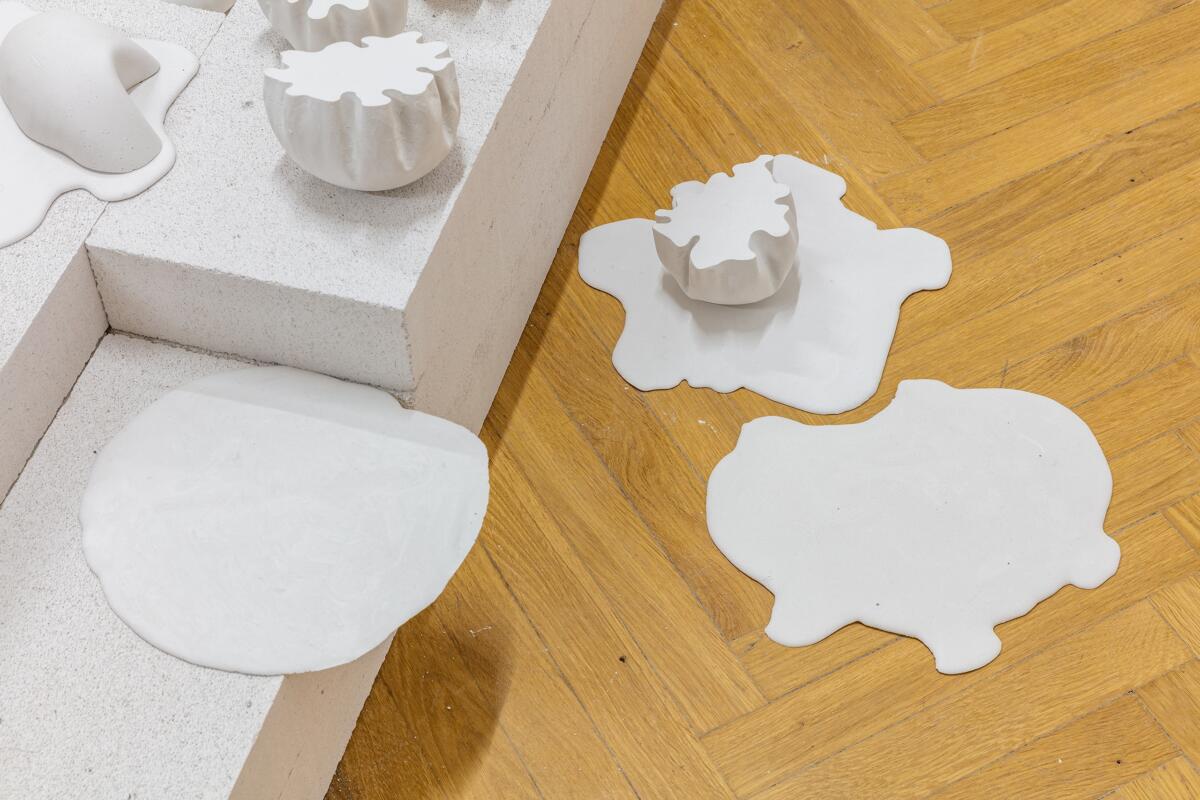
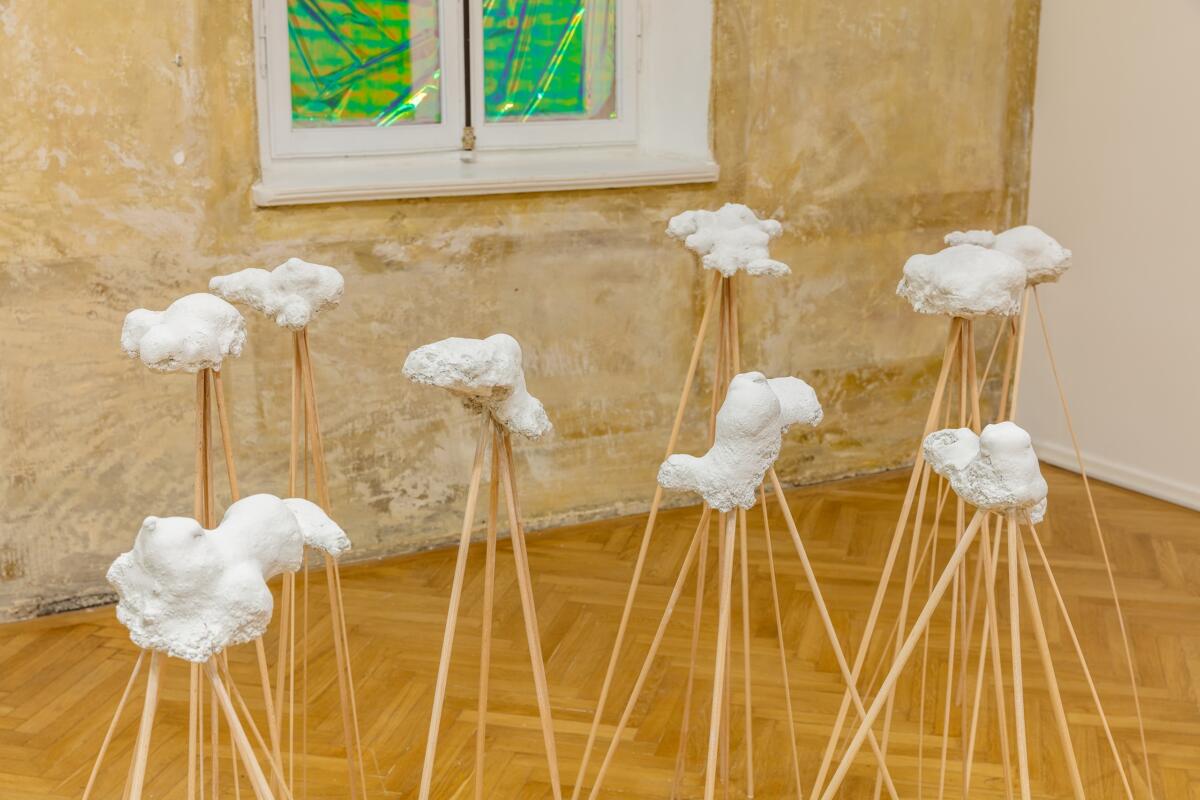
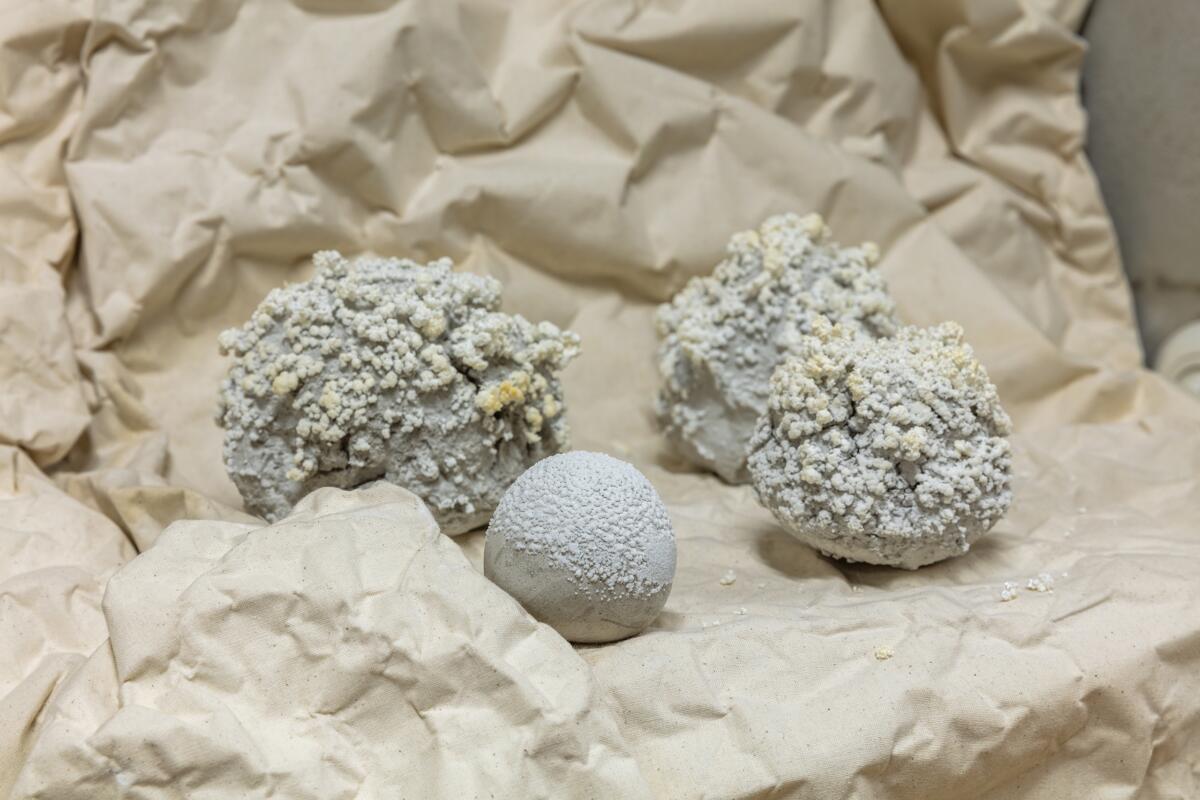
Imprint
| Artist | Anetta Mona Chișa |
| Exhibition | Temporal Parts |
| Place / venue | Anca Poterasu Gallery |
| Dates | 3.11.2021-22.01.2022 |
| Curated by | Cristina Stoenescu |
| Website | ancapoterasu.com/ |
| Index | Adriana Oprea Anca Poterasu Gallery Anetta Mona Chișa Cristina Stoenescu |


